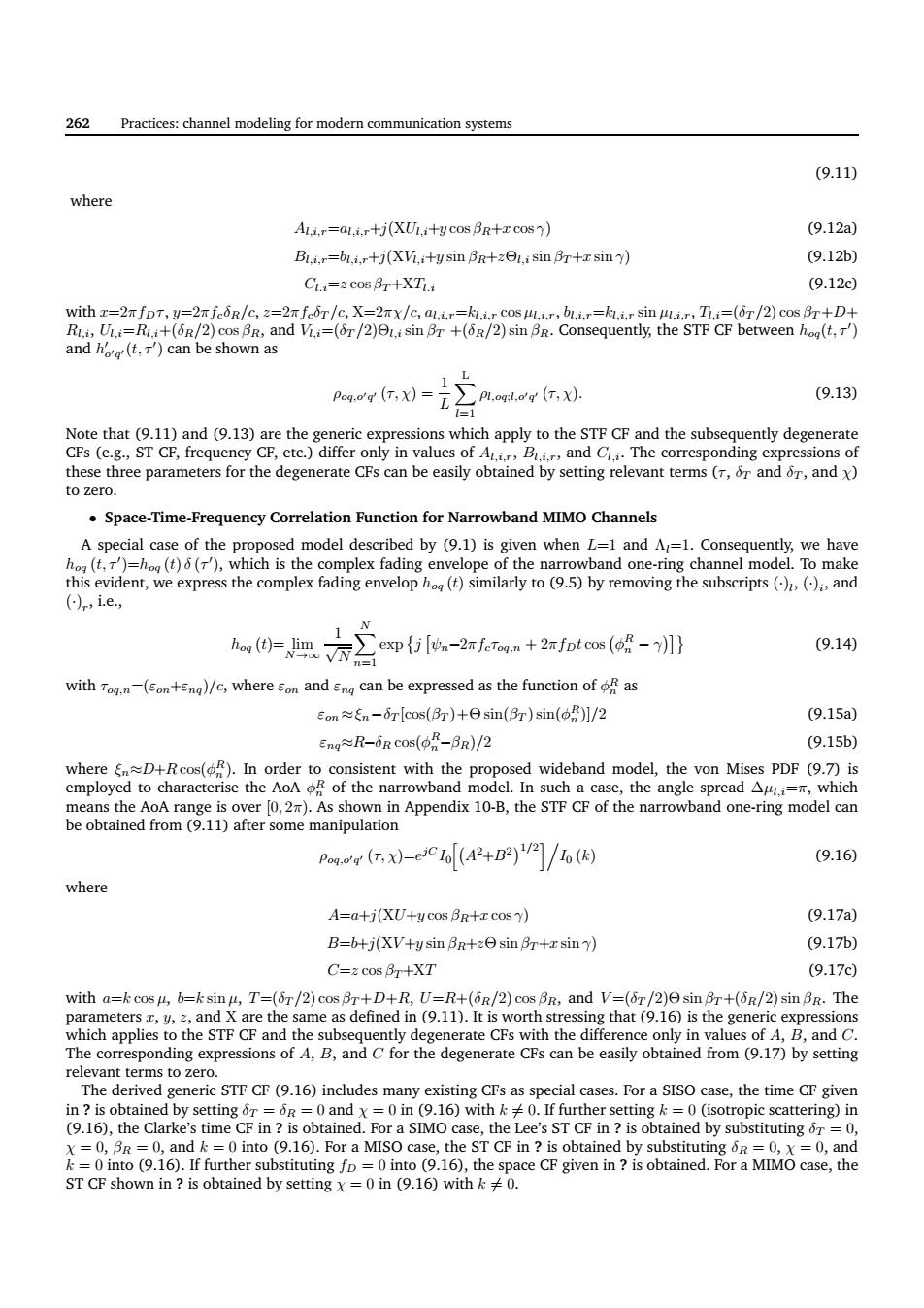正在加载图片...

262 Practices:channel modeling for modern communication systems (9.11) where AL.r=aL..r+j(XU+ycosBR+) (9.12a) BLir=bLir+j(XVi+ysin BR+20Li sin Br+rsin) (9.12b) (9.12) with r=2fDT,y=2fe6R/c,2=2fe6r/c,X=2nx/c,a..=k tween hag(t,T' (9.13) Note that (911)and (913)are the generic expressions which apply to the STCF and the subseqen degenerate n be e Space-Time-Frequency Correlation Function for Narrowband MIMO Channels A special case of the proposed model described by (9.1)is given when L=1 and A=1.Consequently,we have ((which is the complex fac lo mak (ent we expr e complex y removing th bscripts (s(,an 1 h0=不e即66-2sfgn+2 tc(eg-训》 (9.14) with(/c,where and can be expressed as the function of as EonEn-8r[cos(BT)+0sin(Br)sin()/2 (9.15a) eng≈R-Rc0(R-3R)/2 (9.15b) where +Rcs).In order to consistent with the proposed wideband model,the von Mises PDF (9.7)is xc(( (9.16) where A=a+j(XU+ycosr+rcos) (9.17a) B=b+j(XV+ysin Br+zθsin3 r+zsin) (9.17b) C=:cosBr+XT (9.17 with a-=kcos,=ksi which applies to the FCF and the subs y degenerate CFs with thediff ence only in yalues of B.and C The corresponding expressions of.B,and Cfor the degenerate CFs can be easily obtained from (917)by settin The derived eriSTCP (916)includes many existing CFs as special cases.For a SI case,the time CF given =and =0in (9.16)with≠0.If fur ner s n(isotropic)in -0 .and 262 Practices: channel modeling for modern communication systems (9.11) where Al,i,r=al,i,r+j(XUl,i+y cos βR+x cos γ) (9.12a) Bl,i,r=bl,i,r+j(XVl,i+y sin βR+zΘl,i sin βT+x sin γ) (9.12b) Cl.i=z cos βT+XTl.i (9.12c) with x=2πfDτ, y=2πfcδR/c, z=2πfcδT /c, X=2πχ/c, al,i,r=kl,i,r cos µl,i,r, bl,i,r=kl,i,r sin µl,i,r, Tl,i=(δT /2) cos βT+D+ Rl,i, Ul,i=Rl,i+(δR/2) cos βR, and Vl,i=(δT /2)Θl,i sin βT +(δR/2) sin βR. Consequently, the STF CF between hoq(t, τ′ ) and h ′ o ′q ′ (t, τ′ ) can be shown as ρoq,o′q ′ (τ, χ) = 1 L X L l=1 ρl,oq;l,o′q ′ (τ, χ). (9.13) Note that (9.11) and (9.13) are the generic expressions which apply to the STF CF and the subsequently degenerate CFs (e.g., ST CF, frequency CF, etc.) differ only in values of Al,i,r, Bl,i,r, and Cl,i. The corresponding expressions of these three parameters for the degenerate CFs can be easily obtained by setting relevant terms (τ, δT and δT , and χ) to zero. • Space-Time-Frequency Correlation Function for Narrowband MIMO Channels A special case of the proposed model described by (9.1) is given when L=1 and Λl=1. Consequently, we have hoq (t, τ′ )=hoq (t) δ (τ ′ ), which is the complex fading envelope of the narrowband one-ring channel model. To make this evident, we express the complex fading envelop hoq (t) similarly to (9.5) by removing the subscripts (·) l , (·) i , and (·) r , i.e., hoq (t)= lim N→∞ 1 √ N X N n=1 exp j ψn−2πfcτoq,n + 2πfDt cos φ R n − γ (9.14) with τoq,n=(εon+εnq)/c, where εon and εnq can be expressed as the function of φ R n as εon ≈ξn−δT [cos(βT )+Θ sin(βT ) sin(φ R n )]/2 (9.15a) εnq≈R−δR cos(φ R n−βR)/2 (9.15b) where ξn≈D+R cos(φ R n ). In order to consistent with the proposed wideband model, the von Mises PDF (9.7) is employed to characterise the AoA φ R n of the narrowband model. In such a case, the angle spread ∆µl,i=π, which means the AoA range is over [0, 2π). As shown in Appendix 10-B, the STF CF of the narrowband one-ring model can be obtained from (9.11) after some manipulation ρoq,o′q ′ (τ, χ)=e jC I0 h A 2+B 2 1/2i.I0 (k) (9.16) where A=a+j(XU+y cos βR+x cos γ) (9.17a) B=b+j(XV+y sin βR+zΘ sin βT+x sin γ) (9.17b) C=z cos βT+XT (9.17c) with a=k cos µ, b=k sin µ, T=(δT /2) cos βT+D+R, U=R+(δR/2) cos βR, and V =(δT /2)Θ sin βT+(δR/2) sin βR. The parameters x, y, z, and X are the same as defined in (9.11). It is worth stressing that (9.16) is the generic expressions which applies to the STF CF and the subsequently degenerate CFs with the difference only in values of A, B, and C. The corresponding expressions of A, B, and C for the degenerate CFs can be easily obtained from (9.17) by setting relevant terms to zero. The derived generic STF CF (9.16) includes many existing CFs as special cases. For a SISO case, the time CF given in ? is obtained by setting δT = δR = 0 and χ = 0 in (9.16) with k 6= 0. If further setting k = 0 (isotropic scattering) in (9.16), the Clarke’s time CF in ? is obtained. For a SIMO case, the Lee’s ST CF in ? is obtained by substituting δT = 0, χ = 0, βR = 0, and k = 0 into (9.16). For a MISO case, the ST CF in ? is obtained by substituting δR = 0, χ = 0, and k = 0 into (9.16). If further substituting fD = 0 into (9.16), the space CF given in ? is obtained. For a MIMO case, the ST CF shown in ? is obtained by setting χ = 0 in (9.16) with k 6= 0.��